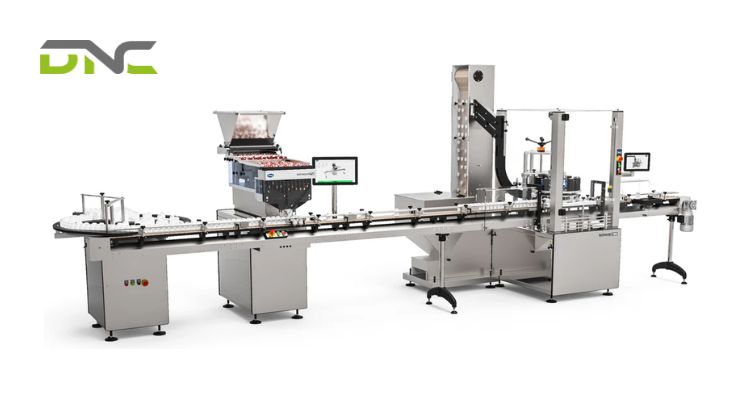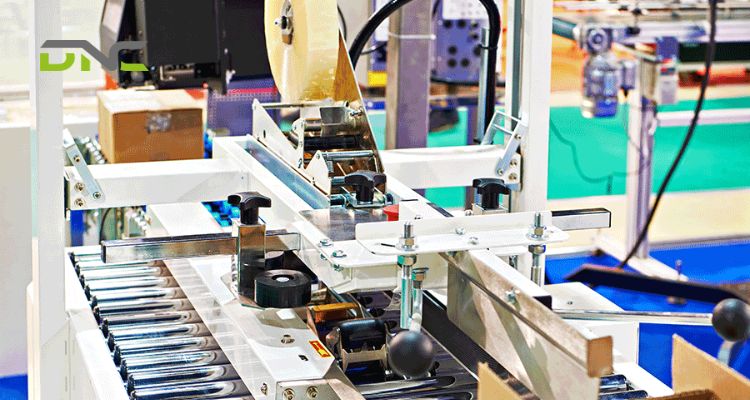Automatic Tablet Packing Machine
An automatic tablet packing machine is a specialized pharmaceutical system designed to fill, count, seal, and label tablets or capsules with minimal human intervention. It ensures consistency, hygiene, and regulatory compliance while maximizing production throughput.
How Automatic Tablet Packing Machines Work?
The process typically follows these steps:
- Feeding – Tablets are loaded into a hopper and evenly distributed using a vibration or rotary feeder.
- Counting – High-precision sensors or electronic counters detect and count each tablet with minimal error.
- Filling – The counted tablets are dispensed into blister cavities, strips, or bottles automatically.
- Sealing – Heat sealing or induction sealing ensures airtight protection against moisture and contamination.
- Labeling and Inspection – Labels are applied automatically, followed by vision inspection for accuracy and defect detection.
- Discharge – The packed units are sent for cartoning or final packing before distribution.

How Automatic Tablet Packing Machines Work?
What Types of Automatic Tablet Packing Machines?
- Blister Packing Machines: Used for PVC/Alu or Alu/Alu blister packs, these machines form plastic cavities (thermoforming or cold-forming), fill them with tablets, and seal with foil. They’re ideal for individual-dose pharmaceutical packaging.
- Strip Packing Machines: Designed for heat-sensitive or moisture-sensitive tablets, this system seals tablets between laminated foil strips, offering strong barrier protection and easy perforation for dosage convenience.
- Bottle Packing Lines: Best suited for bulk production. These integrate electronic tablet counters, desiccant inserters, cappers, induction sealers, and labelers – ensuring efficient packaging for large-scale pharmaceutical operations.
What Are the Components of an Automatic Tablet Packing Machine
Behind every efficient tablet packing line is a network of precision-engineered components that work together to deliver speed, accuracy, and quality assurance.
- Feeding and Counting Systems: Vibratory feeders and photoelectric or optical sensors ensure accurate tablet feeding and counting. Integrated PLC control enables error-free operation and synchronization with filling and sealing units.
- Sealing and Labeling Systems: Heat-sealing jaws (for blisters) or induction sealers (for bottles) create airtight protection. Labeling systems automatically print and apply batch codes, ensuring product traceability and compliance.
- Control and Inspection Systems: PLC, HMI, and SCADA integration allow full process visibility and control. Vision inspection systems like Cognex detect miscounts, broken tablets, or label defects before final packaging.
- Material Handling and Discharge Units: Conveyors and automated discharge units streamline transfer between stations, improving line efficiency and minimizing downtime.
 Benefits of Automatic Tablet Packing Automation
Benefits of Automatic Tablet Packing Automation
Automation in tablet packaging delivers measurable advantages in speed, accuracy, and compliance, helping pharmaceutical producers meet both production and regulatory demands efficiently.
- Enhanced Productivity and Speed: Automated packing lines achieve continuous high-speed operation with minimal human intervention. The result: improved throughput and reduced cycle time, enabling faster time-to-market.
- Unmatched Accuracy and Consistency: With advanced counting sensors and vision systems, these machines eliminate manual counting errors, ensuring every blister or bottle contains the exact number of tablets required.
- Regulatory Compliance (GMP, FDA, NPRA): Automatic machines are designed to meet strict GMP and NPRA Malaysia standards. They provide digital documentation, batch tracking, and validation support for audits and certifications.
- Improved Worker Safety and Hygiene: Reduced manual contact minimizes contamination risks and ensures compliance with pharmaceutical cleanroom protocols.
- Cost Efficiency and ROI: Although the initial investment can be high, long-term savings come from reduced labor, waste minimization, and improved yield accuracy
Technology Behind Modern Tablet Packing Systems
Today’s automatic tablet packing machines integrate smart technologies that drive accuracy, speed, and real-time monitoring for pharmaceutical manufacturing.
- PLC and HMI Control Systems: Siemens or Omron PLCs offer centralized control with user-friendly HMIs for easy setup, parameter tuning, and fault diagnosis.
- Vision Inspection and Quality Assurance: Advanced camera systems detect broken or missing tablets and verify labeling accuracy, ensuring zero-defect output.
- Servo Motor Drives and Synchronization: Servo technology provides precise motion control, ensuring smooth coordination between filling, sealing, and labeling units.
- Data Integration via SCADA Systems: SCADA allows real-time monitoring, batch recording, and predictive maintenance, supporting Industry 4.0 traceability and data-driven decision-making.
- IoT and Smart Connectivity: Remote diagnostics and performance monitoring help maintenance teams quickly identify issues, reducing unplanned downtime.

Technology Behind Modern Tablet Packing Systems
Why Choose DNC Automation as Your Pharmaceutical Packaging Partner
With over a decade of automation experience, DNC Automation is one of Malaysia’s trusted system integrators for pharmaceutical and packaging automation.
- End-to-End Expertise: From concept design to installation and GMP validation, DNC delivers turnkey solutions tailored for the pharmaceutical industry.
- Advanced Integration: Seamless connection with PLC, HMI, SCADA, and vision inspection technologies ensures complete process control.
- Regulatory Compliance: DNC’s automation systems meet GMP, NPRA, and international validation standards, ensuring audit-ready performance.
- Local Support and Service: With a dedicated engineering team in Malaysia, DNC provides ongoing technical support, maintenance, and training.
- 0 views
- 0 Comment



 Benefits of Automatic Tablet Packing Automation
Benefits of Automatic Tablet Packing Automation
Recent Comments